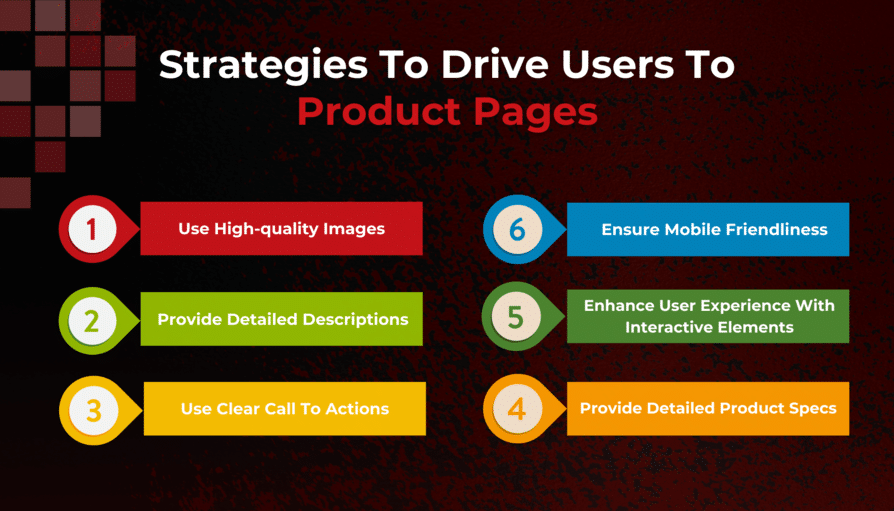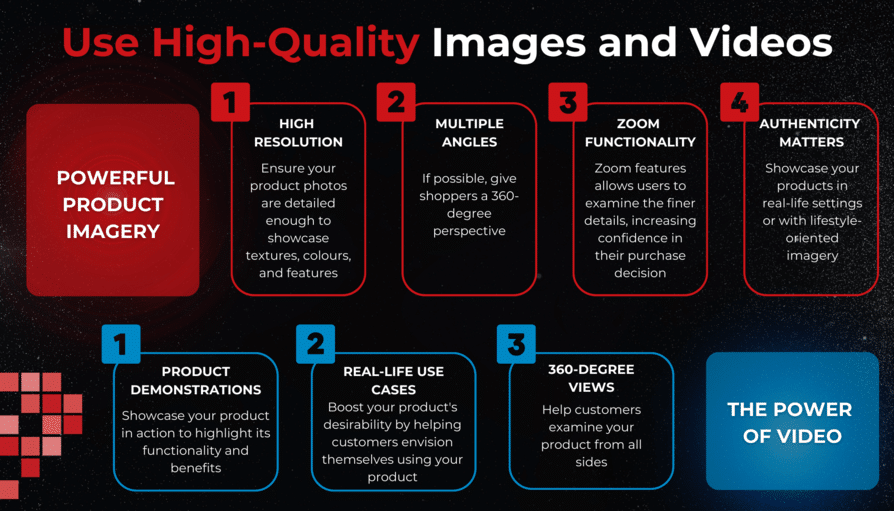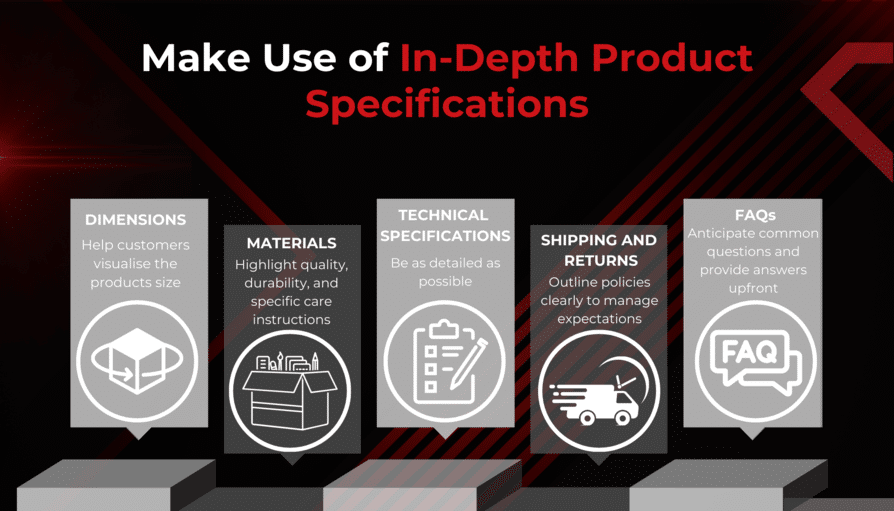Online shoppers make quick judgments. Your product page has seconds to impress and persuade the user to hit that “buy” button… or bounce to a competitor. A well-crafted product page is the key to exceptional user experience optimisation, leading to higher conversion rates and increased sales.
Let us explore the essential elements and best strategies to drive users to product pages you need for e-commerce success:
- High-quality images
- Detailed descriptions
- Clear call to actions
- Detailed product specs
- Interactive elements to enhance user experience
- Mobile friendliness

#1 – Use High-Quality Images and Videos
In the world of online shopping, visuals reign supreme. High-quality images and videos are crucial for building trust, providing clarity, and enhancing overall usability in user experience. After all, customers cannot touch or try on your products before they buy. Visuals bridge that gap.
Tips for Powerful Product Imagery:
- High Resolution:Crisp, clear images are non-negotiable. Ensure your product photos are detailed enough to showcase textures, colours, and features accurately.
- Multiple Angles:If possible, give shoppers a 360-degree perspective. Include shots from the front, back, sides, and any unique angles that highlight your product’s best features.
- Zoom Functionality:Let customers get up close and personal. Zoom features allow them to examine the finer details, increasing confidence in their purchase decision.
- Authenticity Matters:Ditch the generic stock photos. Showcase your products in real-life settings or with lifestyle-oriented imagery to create a more compelling and relatable experience.
The Power of Video
Videos take your product pages to the next level. Consider incorporating:
- Product Demonstrations: Show your product in action, highlighting its functionality and benefits.
- Real-Life Use Cases: Help customers envision themselves using your product, boosting its desirability.
- 360-Degree Views: If fully interactive 360 views are not possible, videos can give customers a similar experience of examining a product from all sides.
By investing in high-quality visuals, you will create a more engaging and informative shopping experience, ultimately driving conversions and improving your bottom line.

#2 – Write Detailed and Persuasive Product Descriptions
Think of your product descriptions as your online sales assistant. While images captivate, descriptions inform, persuade, and ultimately help close the deal. Detailed and well-written product descriptions are essential for enhancing user experience and driving conversions.
Tips for Crafting Compelling Descriptions:
- Focus on Benefits, Not Just Features:Don’t just list specifications, explain how those features translate into tangible benefits for the customer. How will this product make their life easier, better, or more enjoyable?
- Address Pain Points:Understand your customers’ challenges and desires. Tailor your descriptions to show how your product directly solves their problems or fulfils their needs.
- Use Persuasive Language:Employ descriptive, positive, and action-oriented words that create a sense of excitement and urgency.
- Tell a Story:Weave a narrative around your product. How does it fit into the customer’s life? Paint a picture that helps them envision themselves using and enjoying it.
By crafting descriptions that resonate with your target audience, you will answer their questions, alleviate any doubts, and give them a compelling reason to click that “Add to Cart” button.
#3 – Create Clear and Compelling Call-to-Actions (CTA)
Your call-to-action (CTA) is the signpost that guides customers towards the finish line – the purchase. A clear and compelling CTA is crucial for increasing conversions and optimising your product page’s effectiveness.
Characteristics of an Effective CTA:
- Visibility:Your CTA button should stand out visually. Use contrasting colours and place it prominently above the fold (the immediately viewable area of the page).
- Persuasive Language:Use strong action verbs (e.g., “Add to Basket,” “Buy Now,” “Discover More”) to encourage immediate action.
- Urgency:Create a sense of scarcity or exclusivity to nudge customers toward a decision. Phrases like “Limited Time Offer” or “Only a Few Left” can be effective.
Additional Tips
- Test different CTAs: Experiment with variations in wording, colour, and placement to find what works best for your audience.
- Use multiple CTAs: Consider placing CTAs both at the top and bottom of your product page so the potential buyer does not have to scroll up and down looking for them.
A well-crafted CTA gives users a clear next step, eliminating hesitation and boosting your chances of a successful sale.
#4 – Make Use of In-Depth Product Specifications and Additional Information
While captivating visuals and persuasive descriptions are essential, sometimes discerning customers need those nitty-gritty details to seal the deal. Product specifications and additional information provide complete clarity, enhancing the user experience and boosting confidence in their purchase decisions.
Key Information to Include:
- Dimensions:Help customers visualise if a product fits their space or needs.
- Materials:Highlight quality, durability, and any special care instructions.
- Technical Specifications:Be detailed if relevant (for instance, screen size for electronics, ingredients for food items, etc.).
- Shipping and Returns:Outline policies clearly to manage expectations.
- FAQs:Anticipate common questions and provide answers upfront.

Organising Information for Easy Understanding:
- Clear Formatting:Use headings, bullet points, and tables to make information easily scannable.
- Progressive Disclosure:Present essential details first, with options to “Learn More” for those who want a deeper dive.
- Avoid Jargon:If technical terms are unavoidable, be sure to provide simple explanations or a glossary.
By presenting specifications and additional information in a clear and organised way, you empower customers to make informed decisions without overwhelming them.
#5 – Enhance User Experience with Interactive Elements
Interactive elements take your product pages from static to dynamic. They give customers a more hands-on experience, mimicking the feel of in-store shopping and ultimately increasing engagement and boosting conversions.
Popular Interactive Features:
- 360-Degree Views: Allow customers to rotate and examine products from all angles, ideal for items where visual detail is crucial.
- Colour Swatches: Let customers visualise different colour options instantly, enhancing their decision-making.
- Size Selectors: Ensure customers choose the right size with clear, easy-to-use selectors that may dynamically update availability.
- Virtual Try-On: Use augmented reality (AR) technology to let customers “try on” clothes, makeup, or accessories.
- Customisation Tools: Allow customers to personalise products with text, images, or design choices.
Benefits of Interactivity:
- Increased Engagement:Interactive elements make shopping more fun and immersive, keeping customers on your page longer.
- Reduced Uncertainty:Allowing customers to interact with a product helps them feel more confident in their purchase decisions.
- Boosts Conversions:Greater engagement and reduced hesitation lead to a higher likelihood of customers completing the purchase process.
Note: Choose interactive elements strategically based on your products and target audience. Start with the most impactful features and expand over time.
#6 – Optimise Product Pages for Mobile
With more and more people shopping from their smartphones, mobile-responsive design is essential for reaching the widest possible audience and improving user experience across all devices.
Why Mobile Optimisation Matters:
- Expanded Audience:Mobile users make up a massive portion of online shoppers. Failing to cater to them means missing out on potential sales.
- Enhance User Experience:Poorly optimised mobile pages lead to frustration, high bounce rates, and lower conversions.
- Search Engine Rankings:Google and other search engines prioritise mobile-friendly websites for better visibility.
Tips for Mobile-Optimised Product Pages
- Speed is King: Mobile users expect fast load times. Optimise images, streamline code, and choose a reliable hosting provider.
- Prioritise Readability: Use clear fonts, ample spacing, and a layout that is easy to scan on smaller screens.
- Touch-Friendly Navigation: Make buttons large enough to tap easily, and design menus that are intuitive to use with fingers.
- Simplify Forms: Minimise the number of fields in checkout forms and make them easy to fill out on a mobile device.
Mobile optimisation is crucial for any successful e-commerce strategy. By tailoring your product pages for mobile users, you will increase reach, improve customer satisfaction, and drive more conversions. Read more about optimising e-commerce websites for mobile here
Bonus Tips!
Looking for a few more ecommerce product page optimisation strategies? We have got you covered!
Harness the Power of Customer Reviews:
- Social Proof: Customer reviews and testimonials build trust and credibility. Display them prominently on your product pages.
- Address Concerns: Highlight reviews that overcome common objections, boosting buyer confidence.
- Encourage Reviews: Make it easy for customers to leave reviews and offer incentives if appropriate.
- Keyword Research: Use relevant keywords in product titles, descriptions, and image alt tags.
- Unique Content: Avoid duplicate product descriptions from manufacturers. Craft your own descriptions to stand out.
- Structured Data: Use schema markup to help search engines understand your product information.
In Closing:
Your product pages are the heart of your e-commerce success. By carefully considering each element we have discussed above, you can create pages that are both visually compelling and highly informative, leading to exceptional user experiences.
Key Takeaways:
- High-quality visuals build trust and clarity.
- Persuasive descriptions sell the benefits, not just features.
- Clear CTAs guide customers towards conversion.
- Product specifications empower informed decisions.
- Interactive elements boost engagement and reduce uncertainty.
- Mobile optimisation is crucial for reaching the widest audience.
Implementing these strategies takes your product pages from ordinary to extraordinary, ultimately increasing customer satisfaction and driving more sales.
Need Help?
If you have questions or want expert guidance in optimising your e-commerce product pages, do not hesitate to reach out to us. We have the knowledge and skills to help you create a seamless and conversion-focused online shopping experience!
Explore our:
Conversion Rate Optimisation Strategies



